Radiometric Model and Inter-Comparison Results of the SGLI-VNR On-Board Calibration
Abstract
1. Introduction
2. Solar Calibration
2.1. Radiometric Model
2.1.1. Telescope
- : Digital number of CCD response during solar calibration
- : Measured radiance reflected by the diffuser
- : Gain of telescope
- : Electrical shutter correction coefficient
- : Average of digital number during dark (in earth shade) observation for solar calibration
- : Solar radiance at the average distance of the Earth and Solar
- : Earth-Solar distance
- : β angle correction coefficient
- : Diffuser plate reflectance
2.1.2. Photo Diode Monitor (PD)
- : Digital number of PD response during solar calibration
- : Gain of PD
- : Average of output during dark (in earth shade) observation for solar calibration
2.2. First Year Trend
3. Light-emitting diode (LED) Calibration
3.1. Radiometric Model
3.1.1. Telescope
- DNLED: Integrated digital number of LED calibration
- DN(dark)led: Average of digital number during dark (in earth shade) observation for LED calibration
- : LED radiance
- : LED temperature correction coefficient
3.1.2. PD
- : Digital number of PD response during LED calibration
- : Average of output during dark (in earth shade) observation for LED calibration
3.2. First Year Trend
4. Lunar Calibration
4.1. Radiometric Model
- : Lunar radiance(k=ch1~11,p=pixel)
- : Gain(prelaunch measured)
- : Electrical shutter correction coefficient
- : Integrated digital number
- : Average of digital number of deep space observation data at each pixel
- : Lunar irradiance
- : Total number of pixel
- : Solid angle per pixel
- : Oversampling factor
- : Angle between satellite-moon vector and satellite pitch axis
4.2. First Year Trend
5. Inter-Comparison of Solar, LED, and Lunar Calibration
6. Conclusions
Author Contributions
Funding
Acknowledgments
Conflicts of Interest
References
- Imaoka, K.; Kachi, M.; Fujii, H.; Murakami, H.; Hori, M.; Ono, A.; Igarashi, T.; Nakagawa, K.; Oki, T.; Honda, Y.; et al. Global Change Observation Mission (GCOM) for Monitoring Carbon, Water Cycles, and Climate Change. Proc. IEEE 2010, 98, 717–734. [Google Scholar] [CrossRef]
- Uchikata, T.; Tanaka, K.; Okamura, Y.; Tsuida, S.; Amano, T. Proto Flight Model (PFM) performance and development status of Visible and Near Infrared Radiometer (VNR) on the Second-generation Global Imager (SGLI). Proc. SPIE 2014, 9264, 92640Q. [Google Scholar]
- Sakashita, T.; Tsuida, S.; Amano, T.; Shiratama, K.; Tanaka, K. Proto Flight Model (PFM) development status of visible and near-infrared radiometer (VNR) on the Second-generation Global Imager (SGLI). Proc. SPIE 2016, 9881, 98810S. [Google Scholar]
- Tanaka, K.; Okamura, Y.; Amano, T.; Hosokawa, T.; Uchikata, T. The development status of Second Generation Global Imager (SGLI), Infrared Scanning Radiometer (SGLI-IRS). Proc. SPIE 2014, 9264, 92640G. [Google Scholar]
- Tanaka, K.; Amano, T.; Uchikata, T.; Sakashita, T. Early test results of proto-flight test of Second Generation Global Imager (SGLI) Infrared Scanning Radiometer (IRS). Proc. SPIE 2016, 9881, 98810M. [Google Scholar]
- Okamura, Y.; Tanaka, K.; Amano, T.; Shiratama, K.; Hosokawa, T. Development and pre-launch test status of Second Generation Global Imager (SGLI). Proc. SPIE 2015, 9639, 96390I. [Google Scholar]
- Urabe, T.; Ando, S.; Okamura, Y.; Tanaka, K.; Mokuno, M.; Amano, Y.; Shiratama, K.; Yoshida, J. Pre-launch instrument characterization results and in-orbit verification plan of GCOM-C/SGLI. Int. Soc. Opt. Photonics 2017, 10423, 104230O. [Google Scholar]
- Urabe, T.; Okamura, Y.; Tanaka, K.; Mokuno, M. In-orbit commissioning activities results of GCOM-C /SGLI. Int. Soc. Opt. Photonics 2018, 10785, 107850N. [Google Scholar]
- Tanaka, K.; Okamura, Y.; Mokuno, M.; Amano, T.; Yoshida, J. First year on-orbit calibration activities of SGLI on GCOM-C satellite. Proc. SPIE 2018, 10781, 107810Q. [Google Scholar]
- Barnes, R.A.; Holmes, A.W. Overview of the SeaWiFS ocean sensor. In Proceedings of the Sensor Systems for the Early Earth Observing System Platforms, Orlando, FL, USA, 11–16 April 1993; Volume 1939, pp. 224–232. [Google Scholar] [CrossRef]
- Baudin, G.; Matthews, S.; Bessudo, R.; Bezy, J.-L. Medium-Resolution Imaging Spectrometer (MERIS) calibration sequence. In Proceedings of the Imaging Spectrometry II, Denver, CO, USA, 4–9 August 1996; Volume 2819, pp. 141–150. [Google Scholar] [CrossRef]
- Bruegge, C.J.; Diner, D.J.; Duval, V.G. The MISR calibration program. J. Atmos. Ocean Technol. 1996, 13, 286–299. [Google Scholar] [CrossRef]
- Guenther, B.; Barnes, W.; Knight, E.; Barker, J.; Harnden, J.; Weber, R.; Abel, P. MODIS calibration: A brief review of the strategy for the At-launch calibration approach. J. Atmos. Ocean Technol. 1996, 13, 274–285. [Google Scholar] [CrossRef]
- Begni, G.; Dinguirard, M.C.; Jackson, R.D.; Slater, P.N. Absolute calibration of the SPOT-1 HRV cameras. SPIE 1986, 660, 66–76. [Google Scholar]
- Thome, K.J.; Markham, B.; Barker, J.; Slater, P.N.; Biggar, S.F. Radiometric calibration of Landsat. Photogramm. Eng. Remote Sens. 1997, 63, 853–858. [Google Scholar]
- Stone, T.C. Radiometric calibration stability and inter-calibration of solar-band instruments in orbit using the moon. In Proceedings of the Earth Observing Systems XIII, San Diego, CA, USA, 10–14 August 2008; Volume 7081, p. 70810X. [Google Scholar]
- Eplee, R.E., Jr.; Sun, J.-Q.; Meister, G.; Patt, F.S.; Xiong, X.; McClain, C.R. Cross calibration of SeaWiFS and MODIS using on-orbit observations of the moon. Appl. Opt. 2011, 50, 120–133. [Google Scholar] [CrossRef] [PubMed]
- Xiong, X.; Sun, J.; Barnes, W. Inter-comparison of On-orbit Calibration Consistency between Terra and Aqua MODIS Reflective Solar Bands Using the Moon. IEEE Geosci. Remote Sens. Lett. 2008, 5, 778–782. [Google Scholar] [CrossRef]
- Hashiguchi, T.; Okamura, Y.; Tanaka, K.; Nakajima, Y.; Suzuki, K.; Sakashita, T.; Amano, T. Radiometric performance of Second-generation Global Imager (SGLI) using integrating spheres. Proc. SPIE 2016, 10000, 1000007. [Google Scholar]
- Hilsenrath, E.; Herzig, H.; Williams, D.E.; Bruegge, C.J.; Stiegman, A.E. Effects of space shuttle flight on the reflectance characteristics of diffusers in the NIR, VIS, and UV. In Proceedings of the Passive Materials for Optical Elements II, San Diego, CA, USA, 11–16 July 1993; Volume 2018, pp. 104–113. [Google Scholar]
- Petroy, S.B.; Leland, J.E.; Chommeloux, B.; Bruegge, C.J.; Gourmelon, G. Phase 1. Analysis of spectralon(R) material for use in on-board calibration systems for the medium resolution imaging spectrometer (MERIS). SPIE 1994, 2210, 616–624. [Google Scholar]
- Wagner, S.C.; Hewison, T.; Stone, T.; Lacherade, S.; Fougnie, B.; Xiong, X. A summary of the joint GSICS—CEOS/IVOS lunar calibration workshop: Moving towards intercalibration using the Moon as a transfer target. In Proceedings of the Sensors, Systems, and Next-Generation Satellites XIX, Toulouse, France, 21–24 September 2015; Volume 9639, p. 96390Z. [Google Scholar] [CrossRef]
- Kieffer, H.H.; Stone, T.C. The spectral irradiance of the moon. Astron. J. 2005, 129, 2887–2901. [Google Scholar] [CrossRef]
- Urabe, T.; Xiong, X.; Hashiguchi, T.; Ando, S.; Okamura, Y.; Tanaka, K.; Mokuno, M. Lunar calibration inter-comparison of SGLI, MODIS and VIIRS. In Proceedings of the IGARSS 2018—2018 IEEE International Geoscience and Remote Sensing Symposium, Yokohama, Japan, 28 July–2 August 2019. [Google Scholar]
- Xiong, X.; Lacherade, S.; Lebegue, L.; Fougnie, B.; Angal, A.; Wang, Z.; Aznay, O. Comparison of MODIS and PLEIADES Lunar observations. In Proceedings of the Sensors, Systems, and Next-Generation Satellites XVIII, Amsterdam, The Netherlands, 22–25 September 2014; Volume 9241, p. 924111. [Google Scholar]
- Jeong, M.; Kim, S.S.; Garrick-Bethell, I.; Park, S.-M.; Sim, C.K.; Jin, H.; Min, K.W.; Choi, Y.-J. Multi-band polarimetry of the lunar surface. I. Global properties. Astrophys. J. Suppl. Ser. 2015, 221, 16. [Google Scholar] [CrossRef]

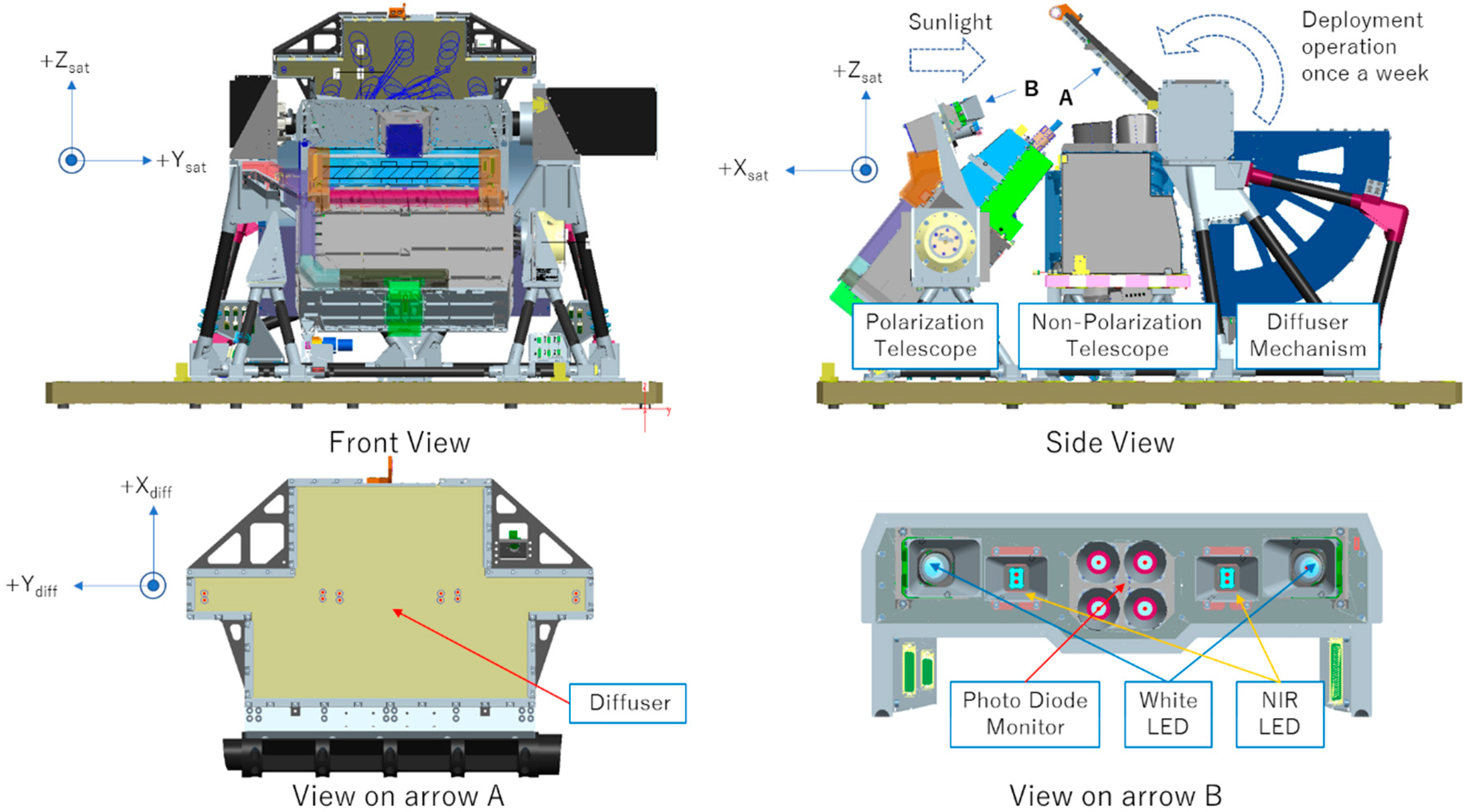
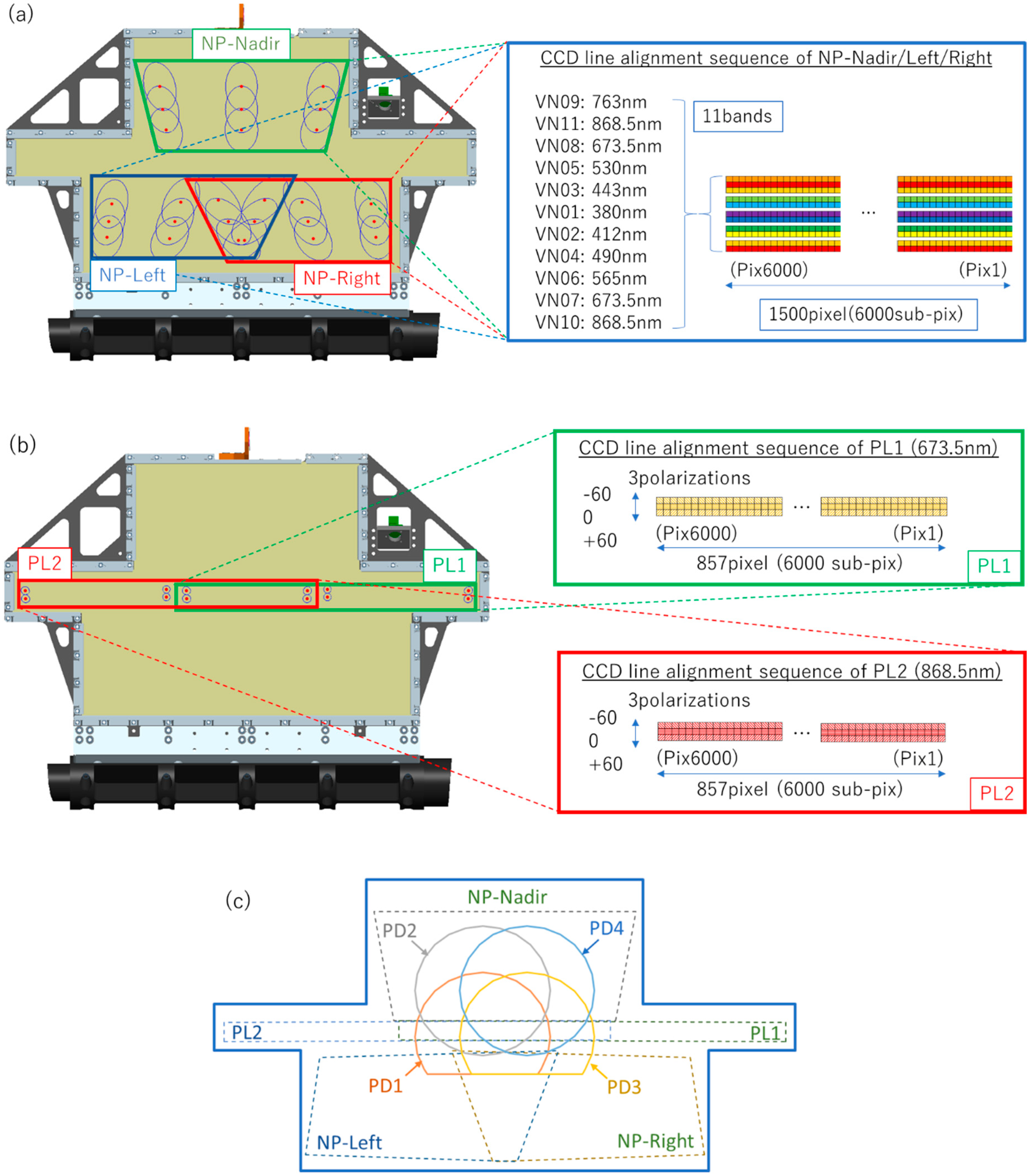


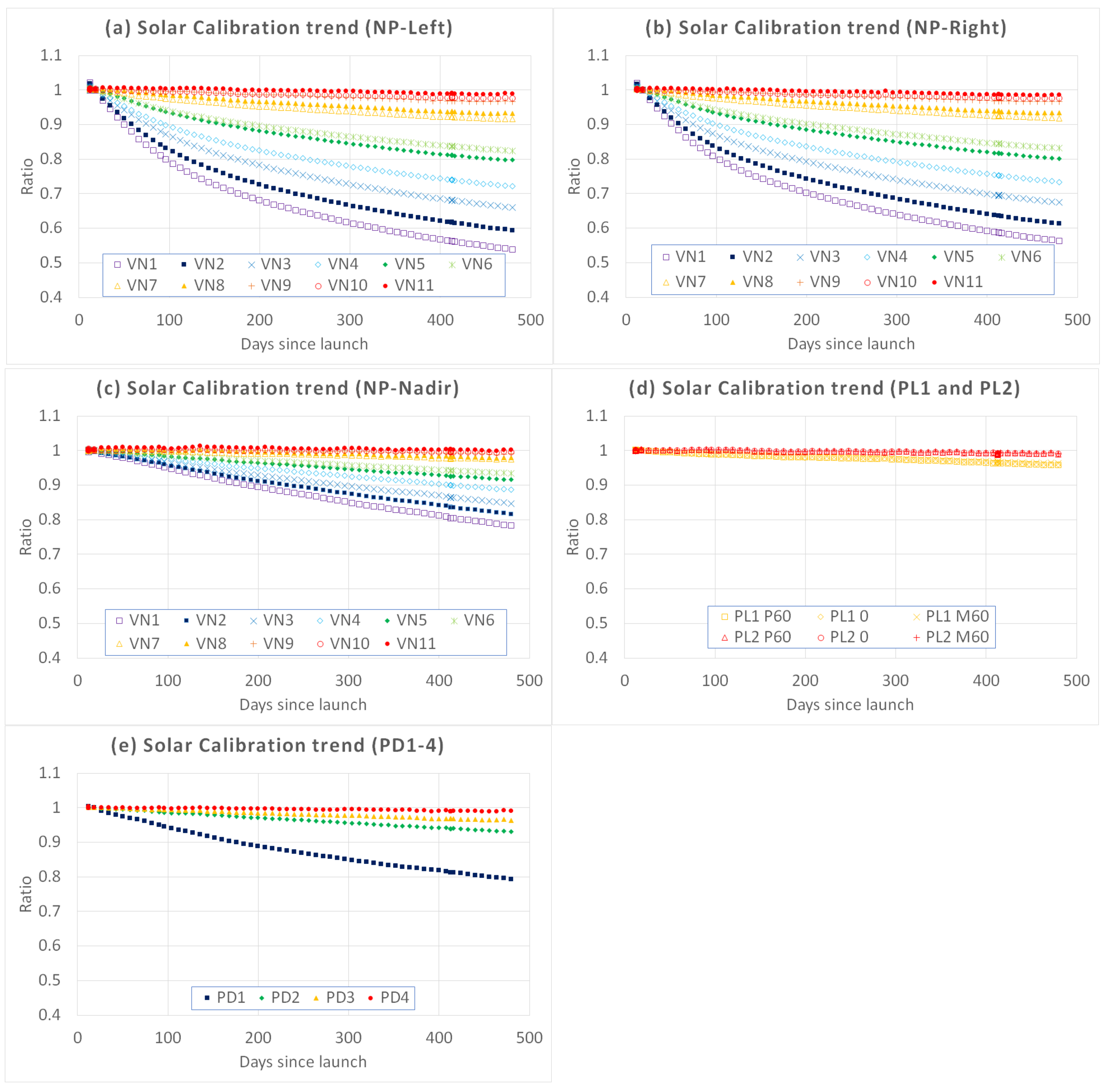
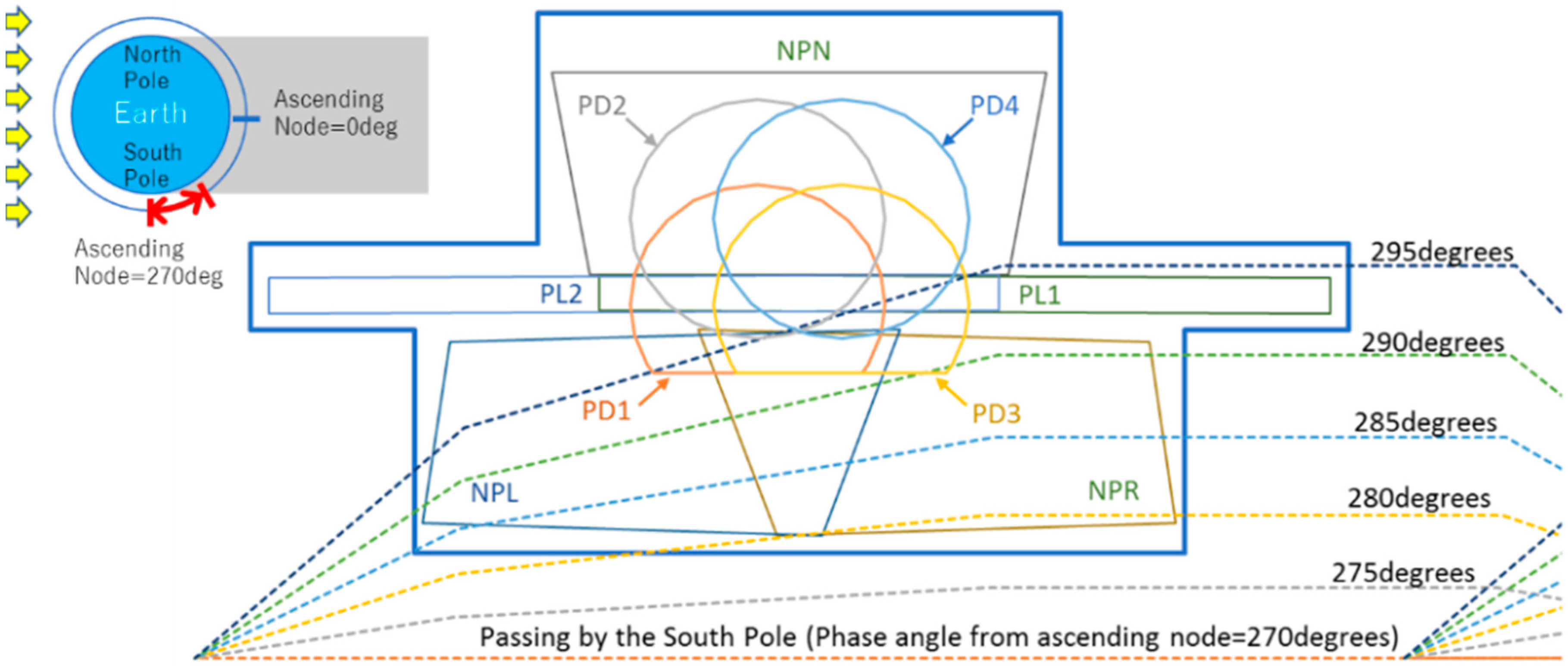

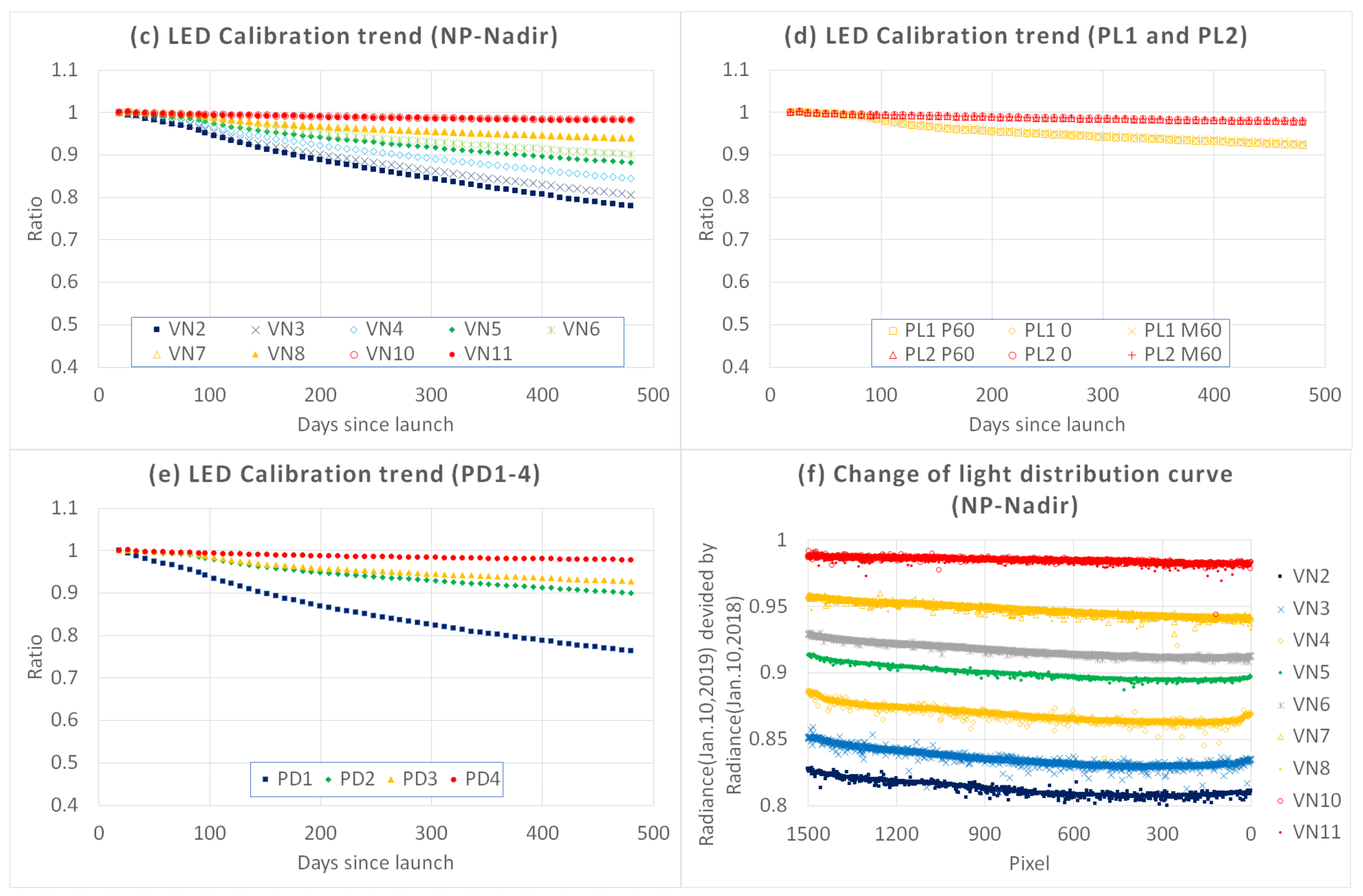
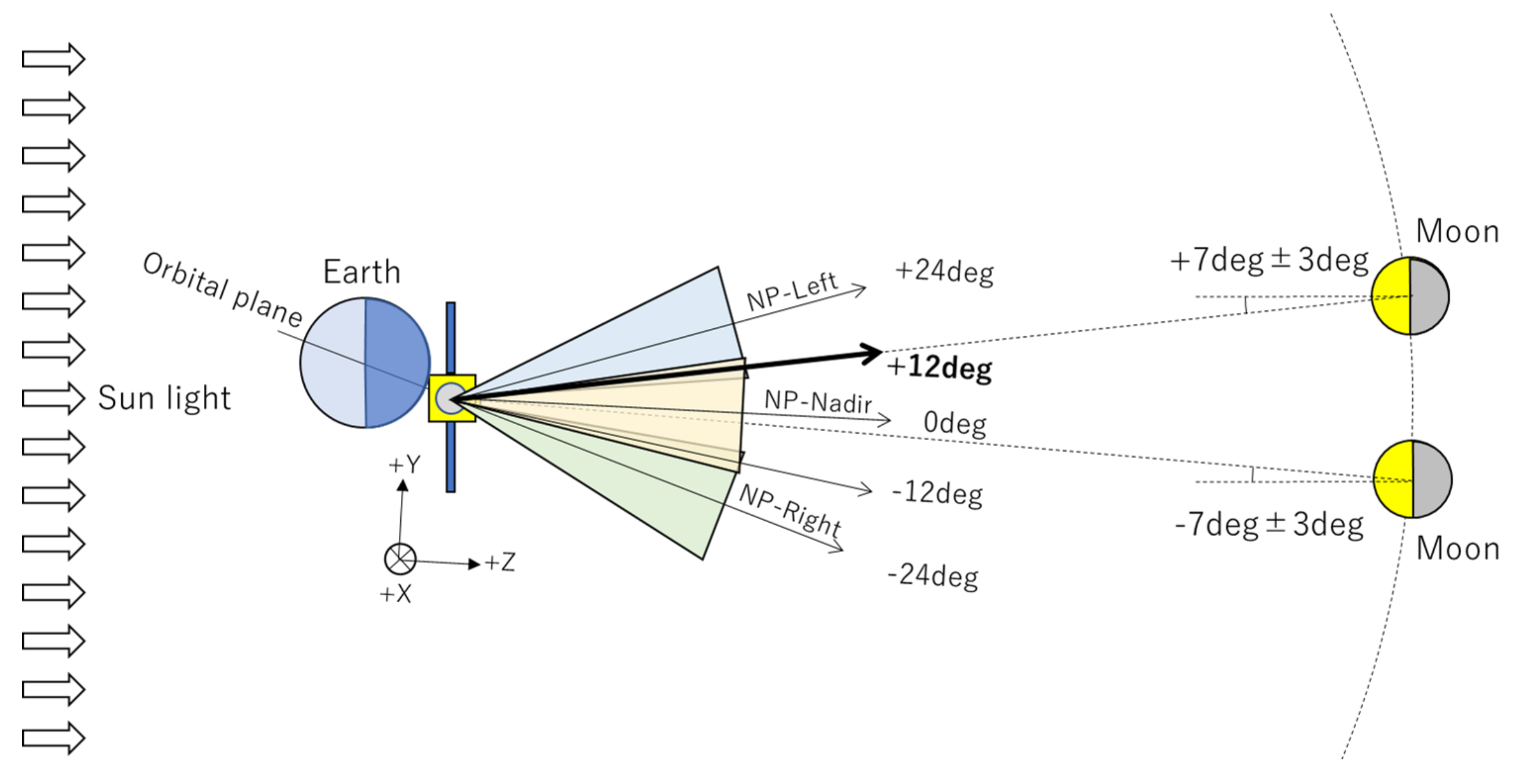

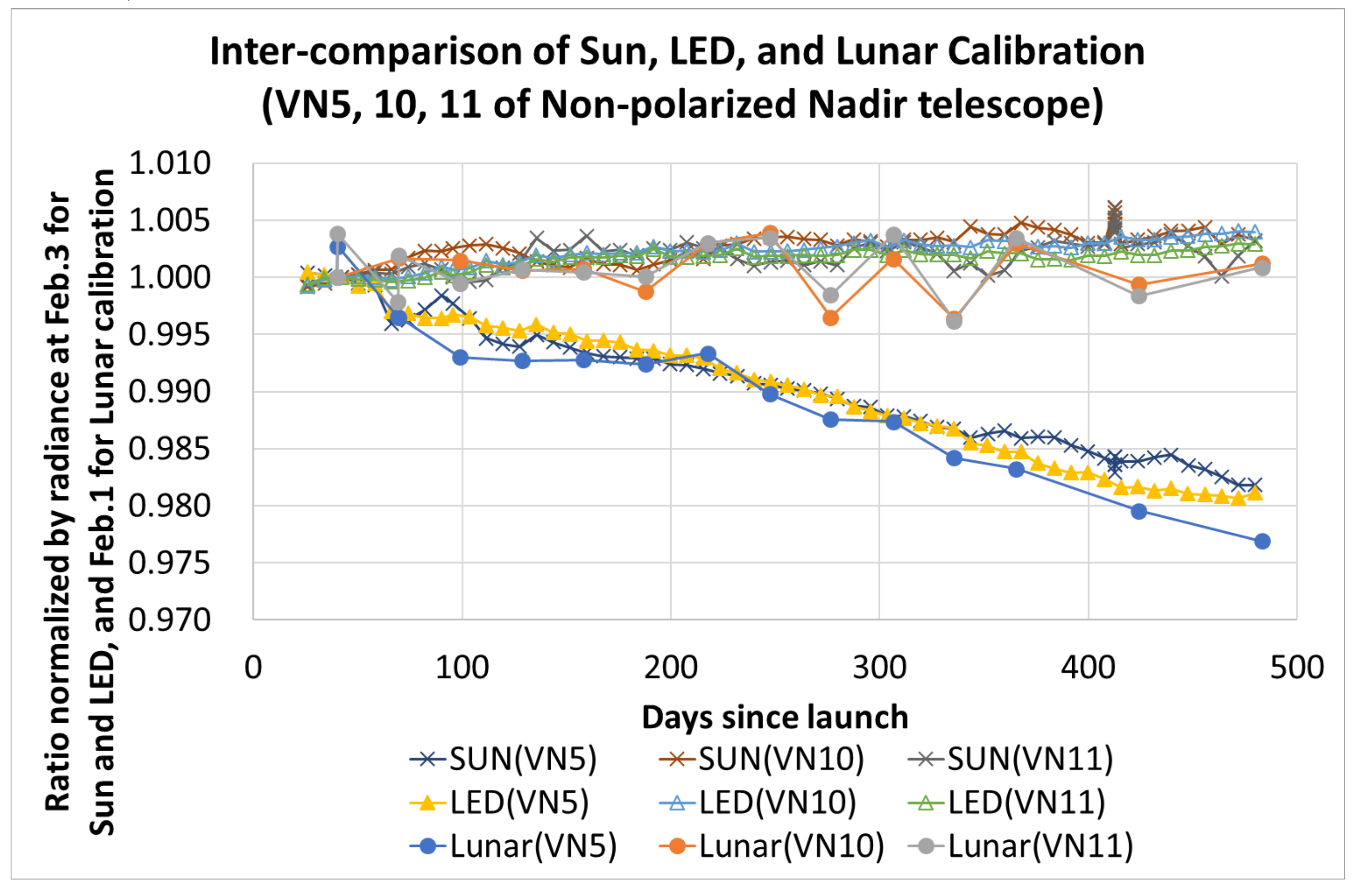
| NP Telescope | PL Telescope | PD Monitor | |||||||
|---|---|---|---|---|---|---|---|---|---|
| Left | Nadir | Right | PL1 | PL1 | PD1 | PD2 | PD3 | PD4 | |
| Pixel (pix) | 101–200 | 501–600 | 1–100 | 301–407 | 51–157 | - | |||
| Zenith angle (degree) | 56–57 | 53–55 | 57–65 | 58–60 | 52–54 | 53–55 | |||
© 2019 by the authors. Licensee MDPI, Basel, Switzerland. This article is an open access article distributed under the terms and conditions of the Creative Commons Attribution (CC BY) license (http://creativecommons.org/licenses/by/4.0/).
Share and Cite
Urabe, T.; Xiong, X.; Hashiguchi, T.; Ando, S.; Okamura, Y.; Tanaka, K. Radiometric Model and Inter-Comparison Results of the SGLI-VNR On-Board Calibration. Remote Sens. 2020, 12, 69. https://doi.org/10.3390/rs12010069
Urabe T, Xiong X, Hashiguchi T, Ando S, Okamura Y, Tanaka K. Radiometric Model and Inter-Comparison Results of the SGLI-VNR On-Board Calibration. Remote Sensing. 2020; 12(1):69. https://doi.org/10.3390/rs12010069
Chicago/Turabian StyleUrabe, Tomoyuki, Xiaoxiong Xiong, Taichiro Hashiguchi, Shigemasa Ando, Yoshihiko Okamura, and Kazuhiro Tanaka. 2020. "Radiometric Model and Inter-Comparison Results of the SGLI-VNR On-Board Calibration" Remote Sensing 12, no. 1: 69. https://doi.org/10.3390/rs12010069
APA StyleUrabe, T., Xiong, X., Hashiguchi, T., Ando, S., Okamura, Y., & Tanaka, K. (2020). Radiometric Model and Inter-Comparison Results of the SGLI-VNR On-Board Calibration. Remote Sensing, 12(1), 69. https://doi.org/10.3390/rs12010069






